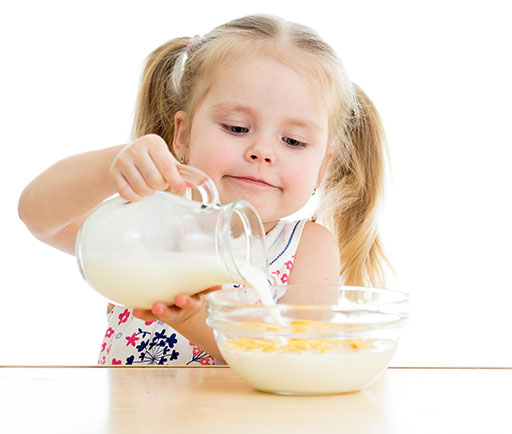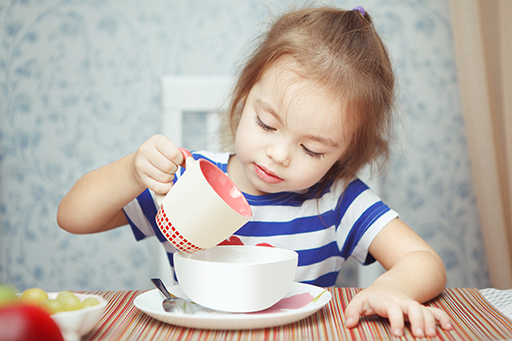Providing additional support
Assessing when and how much support to give to a child with activities can be tricky. All children require support at some point; but how much support? And what is the ‘right’ level? This point is illustrated by the following picture of a child pouring milk from a jug into a bowl.

In this picture you can see how Anna, aged three, is pouring a milk into a bowl. Anna has developed the confidence and dexterity to help herself. Instead of waiting passively for adults to take control, Anna is independently taking care of herself.
This independence will connect with other areas of Anna’s experience from personal care, such as using the toilet to deciding what risks to take in a physical activity such as climbing.
Pouring the milk into a bowl requires good eyesight and the ability to judge distance. Anna needs to have strong hands and arms, and the motor skills to be able to grip the jug.
When Anna first attempted to pour milk she may have needed guidance from an adult, who will have judged when to support and when to step back. And of course, there will have been spilt milk!
Perhaps Anna is confident? Perhaps she is encouraged to do things for herself at home? Another child might feel differently. They might feel anxious about having a go, but they might not know why or be able to tell you.
Activity 1.1 Imagine thinking like a small child
Having looked at the photo of Anna, try to imagine what experiences or emotions might be influencing a child’s approach to pouring milk into a bowl.
Click on the image below then on the larger interactive version itself to reveal some thoughts a child could be having in this scenario.
Many of these emotions are part of the everyday experiences of most children. But some are less common, and adults might need to provide more support than usual.
This might be difficult because young children may not know, or be able to put into words, the reasons behind their emotions. You might have found this when you considered your feelings about studying. Putting feelings into words can be difficult whatever our age.
Adults might need to find out more about the child’s experiences in order to find the best way to help. This will mean building relationships with parents and carers – and, possibly, other professionals.
Adults might need to make changes to the environment to accommodate the needs of children who require additional support.
Look again at the thought bubbles. How might you provide support?
You might like to make notes about your ideas. When you have finished, look at the suggestions we have made.
Discussion
Thinking about your responses to Activity 1.2, read the following section, where we look at some of the reasons why children may need extra support with this activity and suggest some practical tips to support them.
Lack of confidence:
‘I’ll get it wrong, I’m always getting things wrong, I’m useless’
Supporting a child who lacks confidence might require a range of approaches. You might provide one-to-one encouragement, perhaps holding the jug with them and talking about how it feels. It might mean modelling mistakes and how to manage them – perhaps if you spill a little milk or another child overfills a cup, you emphasise how this is acceptable and not something to worry about. It might even include making sure that you are not watching, so that the child can experiment without feeling judged. While you might feel you are focusing on one child, your approach will be creating a supportive environment that will help other children.
Communicating in different ways:
‘I don’t have English words to ask for help’, or ‘I am deaf, I can’t hear what you’re saying’ or ‘I don’t speak confidently’
You need to look for and value all children’s means of communicating.
For a child who speaks in a language you don’t understand, can’t hear you or has difficulty in using spoken language, you can interpret their meaning by watching body language, eye gaze and gestures.
By doing this you will also be modelling to other children that you can communicate without using words. Of course, you can add words to your actions to support language learning and this will help other children who might need support with language.
You may consider learning
- Makaton website [Tip: hold Ctrl and click a link to open it in a new tab. (Hide tip)]
- Signalong website
Children with sensory sensitivities:
‘There is so much noise. I’m not moving because I’m using all my energy and attention to make sense of the sounds around me’
To support children who find it challenging to be in a noisy environment it is important to make changes that support their ability to communicate and to feel part of the setting.
Perhaps you could ensure a smaller group share their snacks at one time to reduce the noise level. Could you have two different snack spaces? Could you invite some children to enjoy a snack outside? Again, making changes to the environment may be supporting other children who are struggling with noise levels. You may consider using pictures or gestures to help children with sequencing.
Perhaps you feel familiar with this diverse and flexible approach to supporting young children? This is additional support for learning.
The social and medical model of disability

